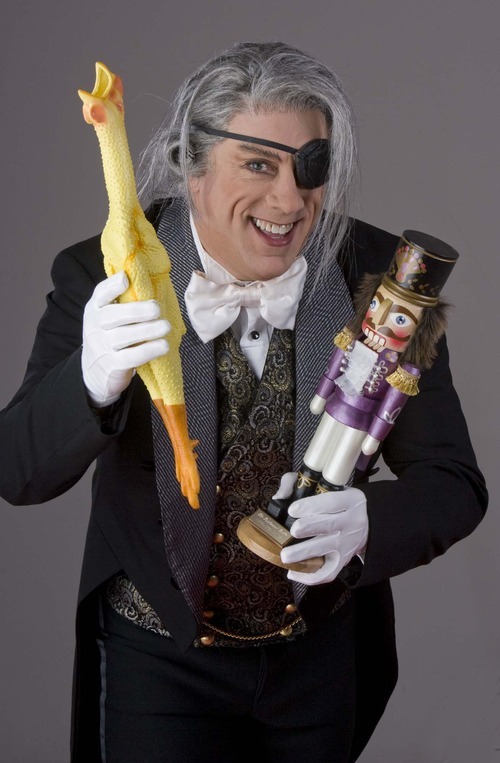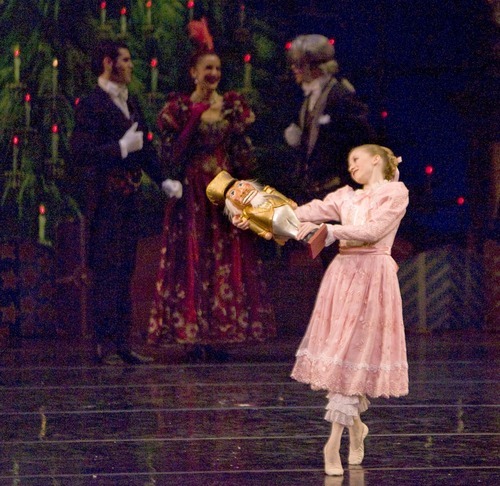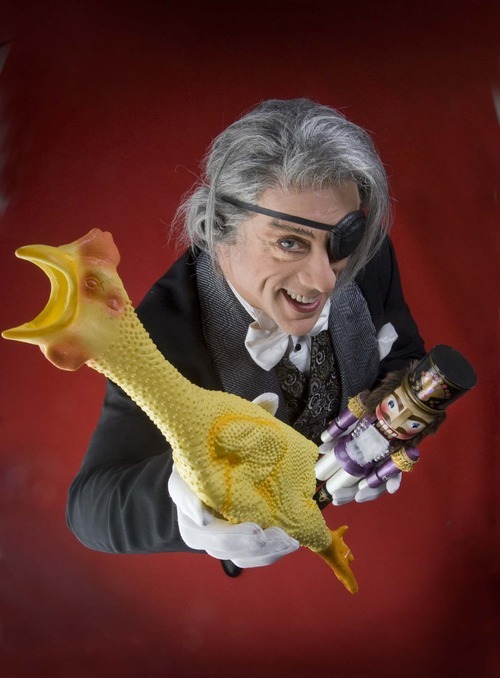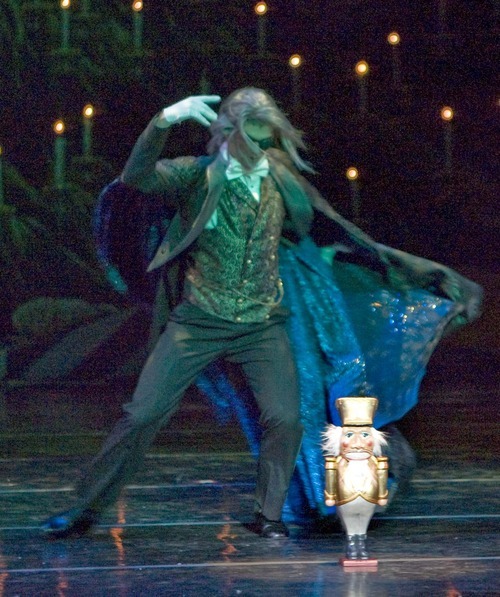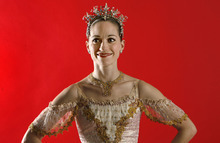This is an archived article that was published on sltrib.com in 2010, and information in the article may be outdated. It is provided only for personal research purposes and may not be reprinted.
There are plum roles, the star turns dancers crave, and then there are Plum roles. Ballet West's beloved "Nutcracker" ballet revolves around the plummiest role of them all, that of the Sugar Plum Fairy.
Young Clara may be the heroine of "The Nutcracker's" plot. But it's the Sugar Plum Fairy, purveyor of all things sweet and good, who becomes Clara's role model for gracious womanhood in what is essentially a coming-of-age story.
She's the character who makes little girls dream of becoming beautiful ballerinas someday — as many who actually did can attest.
Katherine Lawrence, one of six Ballet West artists who will alternate as Sugar Plum Fairy in this season's "Nutcracker," has wanted the role since she was a 6-year-old dancer growing up in Connecticut.
Later, as a corps dancer in Connecticut Ballet's "Nutcracker," she appreciated the kindness of more experienced ballerinas dancing the Sugar Plum role and has tried to emulate their attitude.
"That's really what being the Sugar Plum is about — sugary sweetness," she said. "But it's very hard to find that sugary sweetness when you are doing such difficult stuff."
The Sugar Plum Fairy is among the most difficult roles in the ballet canon, although a talented ballerina can make it look effortless. It requires the dancer to perform a challenging pas de deux filled with bravura lifts, then segue into the signature "Dance of the Sugar Plum Fairy" variation after very little rest backstage.
The intricate Sugar Plum solo looks light and delicate, but it's a difficult test of a ballerina's technique and stamina.
"It's pure classicism," said University of Utah ballet department chair Bené Arnold, who was ballet mistress to Ballet West founder Willam Christensen during early "Nutcracker" productions in Utah and has coached many Sugar Plum Fairies.
"You have to have a wonderful technique," Arnold said. "The ballerina has to have lovely feet and a beautiful line, and has to have the quality of absolute elegance. You have to coach it with the idea that the child in all of us has to fall in love with the Sugar Plum Fairy."
Former Ballet West principal dancer Maggie Wright danced the role scores of times between 1989 and 2004, winning praise for her crisp technique. She learned early on that Christensen expected more. He pulled her aside after attending a performance and told her to make the character softer — more warm and inviting.
"The steps are secondary to the character," Wright said. "It's the Sugar Plums that come out and have no fear in their eyes, and create that essence of magic and beauty, that I admire most."
Tchaikovsky made the music for the variation special by unveiling a new instrument, the music-box-like celesta, to accompany the Sugar Plum Fairy's famous dance, which is heard everywhere during the holiday season.
"He heard the instrument in Paris and loved it so much," said Terence Kern, Ballet West music director and principal conductor. "He brought it back to Russia, but kept it a big secret."
Tchaikovsky's sure sense of musical theatricality is also on display in the grand pas de deux the Sugar Plum Fairy dances with her Prince, Kern said. Using the simplest melodic material — a descending major scale — he created a stunning orchestration that inspires awe. It's all part of the mystique of the Sugar Plum Fairy, a character audiences adore and dancers long to portray.
Ballet West II dancer Kathryn Hein remembers her childhood longing to wear the Sugar Plum Fairy's lovely pointe shoes and pink tutu. Dancing in the "Nutcracker" corps de ballet scenes last year gave her a chance to observe the role through an adult dancer's eyes.
"I have a better understanding of how much strength and stamina is required for the woman who is playing the Sugar Plum," Hein said. "As dancers, we're always trying to get stronger. The Sugar Plum Fairy is strong, but also refined."
Hein hopes to be invited to join the main Ballet West company after this season and aspires to move up through the various feature roles in "The Nutcracker," such as the dancing doll and Snow Queen. Ultimately, she aspires to perform as the Sugar Plum Fairy.
"I feel like that's the top," Hein said. "The Sugar Plum Fairy is something I've admired since I was really little and first started dancing. Dancing that role would be really special, like coming full circle."
'The Nutcracker' season
Ballet West rings in Utah's holiday season with "The Nutcracker," choreographed by company founder Willam F. Christensen to music of Tchaikovsky. Terence Kern conducts the Utah Chamber Orchestra.
When • 24 matinee and evening performances Dec. 4-31. Evening performances begin at 7, with matinees at 2 (and a special holiday matinee Dec. 25 at noon).
Where • Capitol Theatre, 50 W. 200 South, Salt Lake City.
Bonus features • After matinee performances (except Dec. 24 and 31), Ballet West invites children to onstage Sugar Plum Parties, featuring ballet characters and light refreshments. In addition, Ballet West will present "Nutty Nutcracker" performances Dec. 30 at 7 p.m. and Dec. 31 at 2 p.m., featuring flourishes and whimsical surprises woven into the traditional choreography.
Tickets • $18-$72; Sugar Plum parties, $5. For exact performance dates and tickets, call 801-355-ARTS or visit http://www.arttix.org.
On the road • "The Nutcracker" will be performed Friday, Nov. 26, at 7 p.m. and Saturday, Nov. 27, at 2 and 7 p.m. at the Val A. Browning Center, 3750 Harrison Blvd. on the Weber State University campus, Ogden. Tickets are $13-$39. Visit http://www.symphonyballet.org or call 801-399-9214 for tickets. —
A last character turn
Without Herr Drosselmeyer, Ballet West's version of "The Nutcracker" would be just another family party. Not until the eye-patched gentleman weaves his spells does an ordinary Christmas Eve party become a fantasy of growing Christmas trees, giant mice and dancing desserts.
It takes strong stage presence, ballet savvy and talent as a character actor to give Herr Drosselmeyer the aura of mystery and excitement that sparks the "Nutcracker" plot. For 25 years, Peter Christie has been a crowd favorite in the role, setting a standard other dancers work to emulate.
Christie is Ballet West's director of education, but he learned the Drosselmeyer role in 1986 while dancing as a member of the company. Ballet West founder Willam Christensen, who created the company's "Nutcracker" production, helped him hone his characterization.
During Christie's dancing career, he was often cast in character roles, and he preferred them. "I was never the prince," he said. "I was always the one the girl didn't want — the sidekick, the third party."
Modesty aside, Christie was known as one of Ballet West's finest character dancers. He transitioned from dancer to administrator during the 1997-98 season, but continued to dust off his ballet shoes each year to play Drosselmeyer.
The role requires deft character acting but doesn't make heavy technical demands, so Christie could don Drosselmeyer's cape and revisit his days as a dancer despite aging knees and a career change.
But as his administrative duties have multiplied, he's parting with the role. He'll perform as Drosselmeyer one last time this season, during the Christmas Eve matinee, then turn the role over to dancers who have learned from his example.
He says he'll miss the mysterious conjurer he has embodied for 25 Christmas seasons. "It's been fun to keep doing it, and keep in touch with the company in that way," Christie said. "It's kind of a magical role that can really take the ballet in the right direction, to create the mystery, wonder and magic that 'Nutcracker' holds for so many people."


